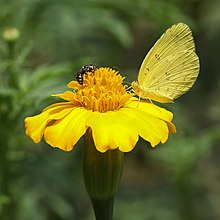Eurema blanda, the three-spot grass yellow,[3][4] is a small butterfly of the family Pieridae which is found in Sri Lanka, India and southeast Asia.[3][4][1][2]
| Three-spot grass yellow | |
|---|---|
 | |
| Phuket, Thailand | |
| Scientific classification | |
| Domain: | Eukaryota |
| Kingdom: | Animalia |
| Phylum: | Arthropoda |
| Class: | Insecta |
| Order: | Lepidoptera |
| Family: | Pieridae |
| Genus: | Eurema |
| Species: | E. blanda |
| Binomial name | |
| Eurema blanda Boisduval, 1836 | |
| Synonyms | |
Description
Wet form: Male. Upper-side lemon-yellow. Fore-wing with the outer marginal black band anteriorly broader than in Sri Lankan specimens of Eurema hecabe, the posterior end shorter and its inner edge outwardly oblique. Hind-wing with a moderately broad black outer band. Underside. Both wings with more or less defined ordinary markings of wet form. Fore-wing with three marks in the cell, in addition to the discocellular. No sub-apical patch. Female. Not seen.
Intermediate form: Male. Not seen. Female. Upper-side. Fore-wing with similar outer band to the wet form. Hind-wing with a broad black outer marginal band. Underside with slightly-defined ordinary brown markings as in wet form. Fore-wing with a brown sub-apical patch.
Dry form: Smaller than in wet form. Male. Upper-side. Fore-wing with narrower outer marginal band, its posterior end much smaller. Hind-wing with a slender outer band. Underside. Both wings with similar ordinary markings to the wet form. Fore-wing with a more or less defined sub-apical patch. Female. Upper-side. Fore-wing with a broader black outer band than in male. Hind-wing with a much broader outer band than in male. Underside. Both wings similar to male.
Extreme Dry form: Male not seen. Female. Upper-side. Fore-wing with a broad black outer band, its posterior portion angled obliquely outward from the lower median veinlet. Hind-wing with a moderately broad outer band. Underside. Both wings with ordinary markings as in dry form. Fore-wing with a prominent almost complete quadrate apical brown patch.
Life Cycle
Egg
Pale yellowish oval-shaped eggs are laid under or upper the leaves and hatch after about three days.
Larva
They are light green in color in first instar and they become bright green color in the last instar.
Pupa
After 20 days from the hatching , the larva become pupa. Pupae are light green in color and , they become butterflies and emerged from the chrysails after a week.
Food plants
Caesalpinia mimosoides and Bauhinia purpurea.[5]


See also
Notes
References
- Evans, W.H. (1932). The Identification of Indian Butterflies (2nd ed.). Mumbai, India: Bombay Natural History Society.
- Gaonkar, Harish (1996). Butterflies of the Western Ghats, India (including Sri Lanka) - A Biodiversity Assessment of a Threatened Mountain System. Bangalore, India: Centre for Ecological Sciences.
- Gay, Thomas; Kehimkar, Isaac David; Punetha, Jagdish Chandra (1992). Common Butterflies of India. Nature Guides. Bombay, India: World Wide Fund for Nature-India by Oxford University Press. ISBN 978-0195631647.
- Kunte, Krushnamegh (2000). Butterflies of Peninsular India. India, A Lifescape. Hyderabad, India: Universities Press. ISBN 978-8173713545.
- Wynter-Blyth, Mark Alexander (1957). Butterflies of the Indian Region. Bombay, India: Bombay Natural History Society. ISBN 978-8170192329.
External links

- "Life cycle of the Three-spot Grass Yellow (Eurema blanda)". Nature Magnified. Retrieved July 6, 2016.